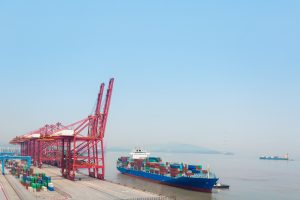Whatever your position is on the U.S.-China Taiwan question, one cannot disagree that an increased conflict between China and Taiwan would result in a massive disruption to global supply chains. We have seen a recent preview into the potential disruption – China’s military drills in response to U.S. House Speaker Nancy Pelosi’s visit disrupted key sea and airspace in the Taiwan Strait. Shipping vessels and planes were forced to find alternate routes in the region.
During Pelosi’s visit, the Chinese Ministry of Defense warned ships and aircraft to remain out of six different areas as China ran drills. Three areas in or near the Taiwan Strait were blocked off, causing ships and planes to cancel or reroute transportation.
While one might think such a narrow strait should be relatively unimportant, there is only one other waterway that ships can travel going to or from the important South China Sea: the Luzon Strait. This would add a few more days to ocean travel time. The Luzon Strait, however, is frequently churned up during typhoon season and therefore risky to travel.
Importantly, most ships end up using the Taiwan Strait on the way from China and Japan to Europe, and even from the United States to Oceania and Asian nations. Half of the global container fleet passed through the strait this year, making it a critical waterway for global supply chains. Taiwan itself is dependent on the strait for trade with China, which, along with Hong Kong, accounts for 40 percent of its exports.
A China-Taiwan conflict would make it difficult to trade through the widely used South China Sea, as the passage to the north would be challenging to move through. The South China Sea is a critical maritime pathway that connects Asia with the rest of the world. As most trading routes are indirect (only 6 percent of trading partners are directly connected), closure of critical waterways has strong knock-on effects on global trade.
Bear with me for a brief thought exercise regarding the cost of a conflict in the Taiwan Strait. If the China-Taiwan conflict were to become a military imbroglio, global supply chains will be disrupted both from an operational and a logistical standpoint. Imagine rerouting half the global container fleet and the costs this would bring. If the core cause is conflict between China and Taiwan, it is likely that much of the trade with China in particular will be severely disrupted.
China accounts for 12 percent of global trade, with many of its exports representing key links in global supply chains. If 12 percent of container ships are going to and from China alone and another 38 percent going to other Asian nations or to the rest of the world, that 38 percent will incur additional costs, especially during typhoon season, which lasts from July through October. Northbound ships that can use the Luzon Strait will not suffer extraordinary costs, but those that cannot will have to double back through the South China Sea, going around the Philippines and/or Indonesia, navigating around additional typhoon formations. This is likely to increase shipping rates, at least in this region, by amounts similar to the pandemic disruptions.
In terms of China’s role in global supply chains, its processing of materials into finished goods accounted for 32 percent of its exports in 2018. That means that other countries continue to rely on China to assemble inputs into final products. In addition, China produces inputs into production, including raw materials and intermediate goods, which comprised 18 percent of its exports in 2019. What that means is that about half of China’s exports represent important parts of global supply chains.
It has also been discussed widely in the media that any China-Taiwan conflict could bring chaos to the semiconductor industry. Taiwan Semiconductor Manufacturing Co. produced 63 percent of global semiconductors in 2020, and almost all of the world’s advanced chips in 2019. The auto industry suffered greatly due to shortages of the chips in the past couple of years, and disruption in the industry would have major effects on sales of advanced electronic products. In addition, half of Taiwan’s exports are comprised of electrical machinery and equipment, which would bring more pain to this industry.
The costs to global supply chains would be quite large, and we’re not even going into the potential cost of the conflict itself. Luckily, firms don’t seem to be taking potential conflict seriously yet. Maritime insurance companies have not elevated the Taiwan Strait to the highest risk category. From their perspective, the Chinese military exercises carried out this month appear to be preplanned. Many multinationals are including a China-Taiwan conflict in their list of risk scenarios, but do not see such a conflict as likely.
Should the possibility of a conflict mount, it is likely that we will see more pinpointed cost estimates and a growing desertion of multinationals from China and the Taiwan Strait region overall. This page has yet to turned. If and when it is, we can expect supply chain costs to surge.
































